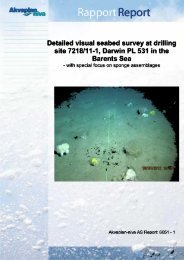A study of the priority substances of the Water Framework Directive ...
A study of the priority substances of the Water Framework Directive ...
A study of the priority substances of the Water Framework Directive ...
Create successful ePaper yourself
Turn your PDF publications into a flip-book with our unique Google optimized e-Paper software.
..:::::::::: chlorfenvinphos<br />
..:::26<br />
8 Chlorfenvinphos<br />
� Chlorfenvinphos is an insecticide which was<br />
legally in use in Norway until 2004, permissions<br />
for use may be obtained until 2006.<br />
� No imports are registered since 2003.<br />
� Chlorfenvinphos was found in four fresh<br />
water localities 1995 - 2001.<br />
� There is a need for new screening <strong>of</strong> chlorfenvinphos<br />
in rivers and streams.<br />
Production and use<br />
Currently in use on cabbage and swede (against<br />
maggots Delia floralis, and Delia radicum).<br />
Product and container is classified as hazardous<br />
waste. No production in Norway.<br />
64 000 kilos organophosphates were sold from<br />
1974-1978 (less than 10 percent probably<br />
Chlorfenvinphos). From 1979 to 2002 43 000<br />
kilos Chlorfenvinphos were sold in Norway.<br />
One product sold in Sweden (Birlane<br />
Granulate), permission expires in 2004, but will<br />
be prolonged by at least one year awaiting EU<br />
decision.<br />
12 201 kilos have been imported since 1996 as<br />
pesticide, no imports since 2003, as <strong>the</strong> product<br />
(Birlane Granulate) is no longer imported by<br />
distributor. Special permissions for use may be<br />
granted to 2006.<br />
Emissions, discharges,<br />
distribution and hot-spots<br />
Pollution is mainly caused by run-<strong>of</strong>f from agricultural<br />
land. No hotspots are found.<br />
Fresh water and groundwater<br />
Chlorfenvinphos was found in four streams in<br />
eastern and south west Norway between 1995<br />
and 2001. The concentrations were high enough<br />
to cause adverse effects on fresh water environment.<br />
Monitoring<br />
Chlorfenvinphos has been monitored in JOVA<br />
since 1995, time series exist.<br />
Need for fur<strong>the</strong>r screening and monitoring<br />
The concentrations found in former monitoring<br />
were quite high. As chlorfenvinphos is being<br />
phased out, a new screening should be initiated.<br />
A <strong>study</strong> <strong>of</strong> <strong>the</strong> <strong>priority</strong> <strong>substances</strong> <strong>of</strong> <strong>the</strong> <strong>Water</strong> <strong>Framework</strong> <strong>Directive</strong><br />
TA-2140/2005<br />
FACTS<br />
Cas no.: 470-90-6<br />
Synonyms: Klorfenvinfos, Birlane, Apachlor, Benzyl<br />
alcohol, Dermaton, 2-chloro-1-(2,4dichlorophenyl)vinyldiethylphosphat.<br />
Properties: Clear/yellowish liquid. Mild odour.<br />
Toxic effects: Very toxic for humans. LD50 rat oral 9,66<br />
mg/kg (HSDB). Very toxic for aquatic organisms. LC50<br />
Guppy (Libistes reticulatus) 0,53 mg/l/(48 hours).<br />
Log Kow: 4.15<br />
Persistence: Half-life in air up to 92 hours, up to 23<br />
weeks in soil, up to 7 weeks in water. Groundwater<br />
unknown. (HSDB)<br />
DT50 water = 70 days (10°C); 7 days (25°C)],<br />
DT50 whole system = 38 - 40,3 days (20°C) CIRCA<br />
<strong>Water</strong> solubility: 3,022 mg/l (25°C)<br />
Molecular formula: C 12 -H 14 -Cl 3 -O 4 -P<br />
Metabolites: orto dealkylated metabolites .<br />
Use: Used for insect control.<br />
Localities for fur<strong>the</strong>r screening and monitoring<br />
The screening <strong>of</strong> Chlorfenvinphos should be initiated<br />
in <strong>the</strong> same rivers and streams which<br />
were investigated by Jordforsk (Report 17/04).<br />
Analysis<br />
The analysis <strong>of</strong> Chlorfenvinphos is <strong>of</strong>ten part <strong>of</strong><br />
multi pesticide packages <strong>of</strong>fered by several laboratories.<br />
Methods<br />
The methods are based on direct extraction with<br />
an organic solvent (sediment and biota) or solid<br />
phase extraction (SPE), eventually clean-up with<br />
SPE and separation and quantification with GCbased<br />
methods: GC/MS or GC/NPD.<br />
Synergy with o<strong>the</strong>r analyses<br />
Sample extraction and clean-up can be co-ordinated<br />
with <strong>the</strong> analysis <strong>of</strong> o<strong>the</strong>r pesticides which<br />
can be analysed by GC/MS especially o<strong>the</strong>r<br />
organophosphorous insecticides as for example<br />
chlorpyrifos, malathion or methyl-parathion.

















